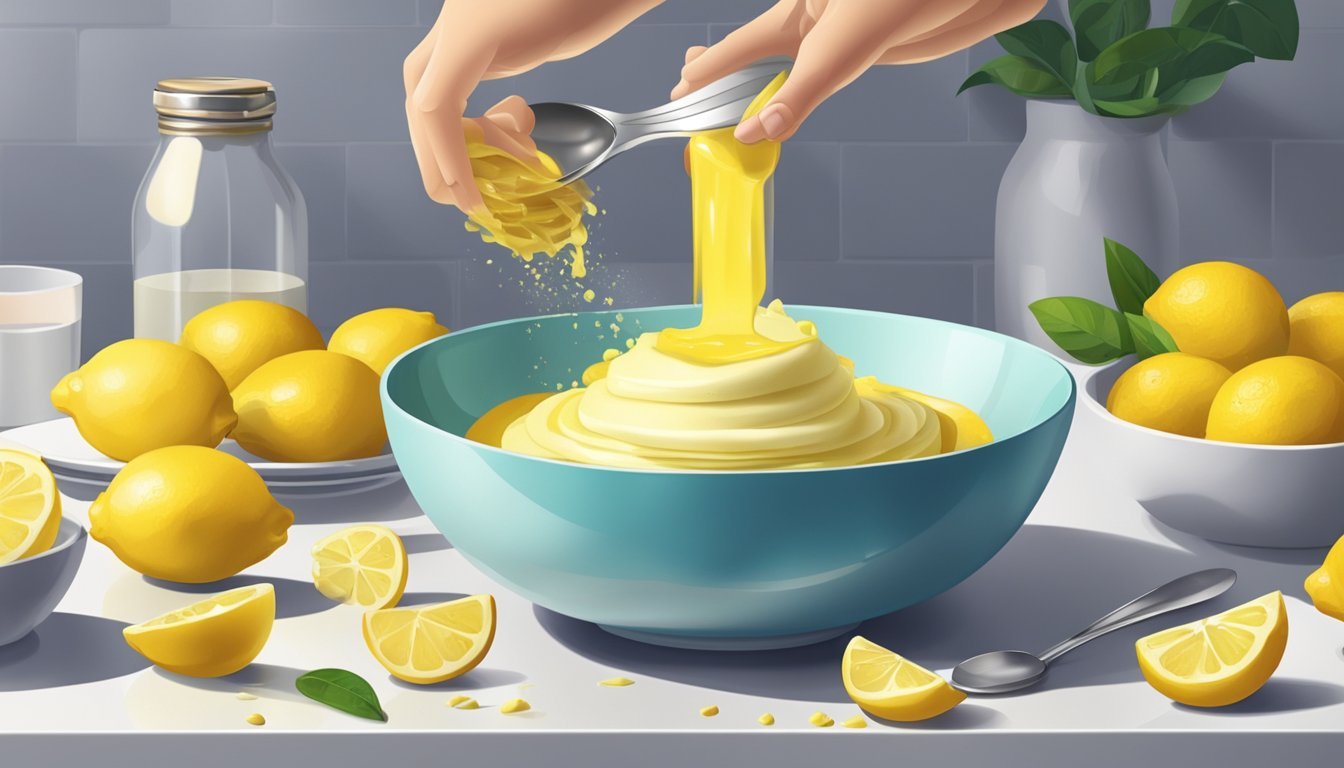Fixing Overly Sweet Desserts
Techniques for Achieving Perfect Flavor Balance
When a dessert turns out excessively sweet, it's essential not to panic; there are various ways to correct the flavor balance. The challenge of overly sweet desserts is commonplace, whether due to a mismeasurement of sugar or the intrinsic sweetness of the chosen ingredients. However, with an understanding of taste and a couple of smart adjustments, one can bring a cloying dessert back to a palatable equilibrium.
The key is to introduce ingredients that introduce contrasting flavors without altering the original intention of the dessert. Acidic elements, such as a dash of vinegar or citrus, can effectively counteract excess sweetness. Salt, used judiciously, can enhance and balance flavors. Implementing these adjustments requires care; the goal is to subtly alter the flavor profile without overwhelming the original dish.
Intriguingly, texture plays a role in the perception of sweetness as well. Introducing elements with a contrasting texture can distract the palate and make a dessert feel less sweet. In essence, correcting an overly sweet dessert is about finding harmony among the basic tastes and ensuring a satisfying experience for the taste buds.
Understanding Flavor Profiles
In the realm of desserts, sweetness is a fundamental component, but its dominance can mask other essential flavors. Achieving the ideal flavor profile requires more than simply adjusting sweetness; it's about creating harmony among all taste sensations.
Sweetness and Its Role in Desserts
Sweetness is the taste typically associated with sugars and certain artificial sweeteners. It is a primary taste sensation in desserts, often setting the baseline for a dish's flavor profile. Taste buds react to sweetness in a way that can be pleasurable and satisfying, explaining its prominent role in desserts.
Identifying the Causes of Overly Sweet Desserts
Sometimes desserts become overly sweet due to a simple miscalculation of sugar or sweet ingredients. However, lack of contrast can also be a culprit; a dessert with minimal bitterness, sourness, or saltiness to counterbalance the sweetness can result in an overpowering sugary taste.
Flavor Balance: Beyond Just Sweet
Achieving balance involves leveraging the full spectrum of taste:
Sweet: Enhances richness and depth.
Bitter: Adds complexity and can tone down excess sweetness.
Sour: Provides a sharp contrast that refreshes the palate.
Salty: Amplifies other flavors and can reduce the perception of bitterness.
Umami: Not commonly targeted in desserts, but can offer a savory note to sophisticated sweet creations.
Each taste contributes to the overall sensory experience, and adjusting these can help to correct an overly sweet dessert, leading to a more nuanced and enjoyable flavor profile.
Techniques for Balancing Sweetness
In desserts, sweetness can overwhelm the palate, but there are reliable techniques one can deploy to create harmony among flavors. By adjusting ingredients and cooking methods, any dessert's sweetness level can be fine-tuned.
Adjusting Sweetness in Baking
Baking demands precision, yet there are ways to rectify a dessert that's too sweet. One can reduce the amount of sugar in the recipe while increasing non-sweet components like flour or fat which include butter to balance the proportions. This ensures that the dessert maintains its texture and structural integrity. Alternatively, incorporating dairy products with natural fats can also help to mute excessive sweetness without altering the desired consistency.
Culinary Methods to Counteract Excess Sugar
Counteracting excess sugar in desserts can be achieved by adding ingredients that introduce contrasting flavors:
Acidic Elements: A squeeze of lemon or a spoonful of cream of tartar adds tartness to contrast the sweet.
Bitter Components: Introducing unsweetened cocoa powder or dark chocolate can counterbalance sweetness and add depth.
Salty Counterparts: A pinch of salt is not only essential in baking but also enhances and balances overall flavors.
The Role of Temperature in Flavor Perception
The perception of sweetness can change with temperature. Serving a dessert chilled can dampen the sweet taste, providing a more balanced flavor profile. Similarly, warming a dessert might increase the perception of sweetness. Dessert creators should consider how temperature will affect the final flavor and make adjustments during preparation accordingly.
Using Ingredients to Correct Sweetness
When desserts are overly sweet, a cook can employ various ingredients to achieve a better balance. Thoughtfully selected additives such as acids, dairy products, or seasoning can harmonize flavors without overwhelming the original dish.
Acidic Additions for Balance
Introducing an acidic element is an effective way to counteract excessive sweetness. A dash of vinegar or citrus juice such as lemon or lime juice can provide the necessary tang. Here's how to incorporate them:
Lemon/Lime Juice: Squeeze fresh lemon or lime to add a vibrant, clean acidity.
Vinegar: A teaspoon of white or apple cider vinegar can subtly cut through the sweetness.
The key is to add these ingredients gradually, tasting as you go, to ensure they complement the dessert without dominating it.
Incorporating Fats and Dairy
Fats and dairy products can mellow out the sweetness while adding richness. Consider the following options:
Sour Cream: A spoonful can impart a gentle tanginess and creaminess.
Yogurt: It offers a similar effect to sour cream with a bit more sharpness.
Milk/Cream: They can dilute sweetness and add a silky texture.
These ingredients should be mixed in carefully to maintain the dish's consistency.
Salt and Spices: Enhancing and Balancing
A minimal amount of salt can heighten other flavors in a dessert, thus bringing down the perception of sweetness. Spices and herbs can also introduce complexity that offsets sugar dominance. Use them judiciously:
Salt: A pinch can enhance existing flavors and balance the overall sweetness.
Spices/Herbs: Opt for ones that complement the dessert's flavor profile, like cinnamon or basil, avoiding any that could clash.
Remember, the addition of these components should be subtle to merely influence, not redefine, the dessert's inherent taste profile.
Alternative Sweeteners and How to Use Them
When fixing overly sweet desserts, it is essential to understand the role of alternative sweeteners and how to balance their flavors. The appropriate use of these sweeteners can rescue a dessert from being cloying while maintaining its intended taste profile.
Natural Sugars and Their Impact
Natural sugars, such as honey and maple syrup, are derived from sources like plants and trees. They come with their own set of flavors and can enhance a dessert beyond mere sweetness.
Honey is sweeter than sugar and adds a distinct floral note to dishes. It's best used in recipes where its strong flavor can complement other ingredients rather than overwhelm them.
Maple Syrup is derived from the sap of maple trees and has a robust, woodsy taste. It serves well in baked goods and can replace granulated sugar using a ratio of 3/4 cup maple syrup to 1 cup sugar, reducing other liquids in the recipe by about 3 tablespoons.
Syrups and Liquid Sweeteners
Liquid sweeteners such as syrups can contribute to both the sweetness and moisture of desserts.
Fruit Syrups, made from reductions of fruit juices, provide sweetness and fruity undertones. They work well in desserts where fruit flavors are desirable.
When substituting syrups for sugar, the general guideline is to use 3/4 of the syrup volume compared to sugar and to decrease the amount of liquid in the recipe by 1/4 to maintain consistency.
Artificial and Sugar-free Options
Sugar-free alternatives can be synthetic or naturally derived and often possess a different sweetness profile compared to sugar.
Artificial sweeteners like Stevia are intensely sweet and can vary in sweetness, up to 200 times more than sugar. Only small amounts are needed, and they often work well in beverages or dishes where minimal alteration of texture is required.
When using sugar-free options, one should adjust to taste, considering how some can have an aftertaste or vary in sweetness from batch to batch. They are commonly used in recipes for dietary restrictions and can often offer the sweetness without the caloric intake of natural sugars.
Remember to tastefully balance these sweeteners, keeping the total flavor profile of the dessert in mind to ensure the outcome is delicious and satisfying.
The Science of Tasting
Proper dessert flavor balancing involves more than just the tongue; it integrates the complex relationship between taste, smell, and texture. Understanding how these elements interact is essential for correcting overly sweet tastes.
How We Perceive Sweet, Sour, and Bitter
The human palate can detect five primary tastes: sweet, sour, salty, bitter, and umami. Sweet is often associated with energy-rich foods, while sour can indicate spoilage or fermentation, and bitter can signal potential poisons. These tastes are recognized by taste receptors on the tongue, which send signals to the brain to interpret flavor. When a dessert is overly sweet, the goal is to introduce sour and bitter elements to create a balanced contrast on the palate.
The Interaction of Taste and Smell
Aroma plays a critical role in how flavor is perceived. Smell and taste are intertwined, with volatile compounds in food traveling to the nasal cavity to impact the overall flavor perception. They are tasting, in reality, is a multisensory experience; both the taste buds and the olfactory receptors contribute to the complexity of flavors perceived. When a dessert is too sweet, incorporating ingredients that offer complementary aromas can enhance or balance the sweetness, creating a more rounded flavor profile.
Textural Considerations in Balance
Texture influences the tasting experience through mouthfeel, which can alter the perception of flavor. A smooth, creamy texture can enhance the sweetness of a dessert, while the addition of a crunchy element might reduce the perception of sweetness and add complexity to the dish. When adjusting texture to balance an overly sweet dessert, chefs must consider the structural role that sugar plays in maintaining the texture. The right combination of texture and flavor can either elevate the sweetness or divert attention, providing a counterbalance.
Practical Applications
In the journey to culinary perfection, balancing flavors is crucial, especially when dishes become excessively sweet. The following techniques offer practical solutions for chefs and home cooks to correct sweetness in various meal components.
Balancing Flavors in Sauces and Soups
When a sauce or soup tastes too sweet, chefs may consider adding acidic ingredients like vinegar or lemon juice to counteract the excess sugar. A dash of salt can be effective as well, but one should use it sparingly to ensure that the sodium level does not become overpowering.
Acidic Ingredients:
Lemon juice
Lime juice
Vinegar (e.g., apple cider, balsamic)
Salt & Umami Enhancers:
Salt
Soy sauce
Anchovy paste
Adjusting Sweetness in Main Courses
For meats and vegetable dishes that err on the sweet side, introducing savory elements or bitter flavors can restore balance. Incorporating ingredients like olives, capers, or a spoonful of prepared mustard can effectively adjust the sweetness of a dish.
Savory Enhancers:
Olives
Capers
Mustard
Beans (e.g., navy, black beans)
Bitter Elements:
Dark leafy greens
Coffee
Desserts and Flavor Correction
Desserts present a unique challenge as their sweetness is often a primary feature. Introducing contrasting flavors or textures can subtly correct sweetness without compromising the desired taste. For instance, nuts or seeds can add both textural contrast and a nutty flavor that complements the overall sweetness of a dessert.
Contrasting Flavors & Textures:
Nuts (almonds, walnuts, pistachios)
Seeds (pumpkin seeds, sunflower seeds)
Dairy-based Adjustments:
Sour cream
Cream cheese
Desserts can also be enhanced with spices that introduce complexity, such as cinnamon, nutmeg, or vanilla extract, allowing for the natural sweetness to be complemented rather than overshadowed.
Creative Solutions
When confronted with an overly sweet dessert, there are various creative ways one can adjust the balance of flavors. These include infusing complementary flavors, incorporating herbs, spices, and savory elements, as well as employing dilution techniques.
Infusing Flavors for Balance
To counteract sweetness, one can infuse the dessert with citrus elements such as lemon or lime. This introduces a tart profile that can effectively balance the flavor. Likewise, a splash of citrus juice or zest can provide a quick fix. Adding fruits with a sour or bitter edge, such as certain berries, can alter the overall flavor profile while contributing to the dessert’s complexity.
Herbs, Spices, and Savory Elements
Incorporating herbs and spices can introduce an earthy or spicy dimension to the dessert, which helps in balancing the sweetness. Consider the following options:
Cinnamon or nutmeg: Creates a warm spice undertone.
Mint or basil: Offers a fresh herbal note.
Black pepper or ginger: Adds a subtle kick of spice.
One should apply these flavors judiciously to avoid overwhelming the original taste of the dessert. A small pinch of savory elements can sometimes deliver the needed complexity to reduce perceived sweetness.
Dilution Techniques
The method of dilution involves adding components that are neutral or complementary in flavor. Utilize water or unflavored dairy to subtly dilute the sweetness without distorting the essence of the dessert. Here's a simple approach:
Add extra base ingredients: For batters or creams, mix in more flour, milk, or cream to decrease the concentration of sugar.
Incorporate neutral elements: Consider tofu or yogurt for creaminess with less sweetness.
Dilution must be done with care to maintain the dessert's desired texture and consistency. Each addition should be followed by taste-testing to ensure the optimal balance is achieved.
Recipe Adjustments and Measurements
This section is dedicated to understanding the importance of precise measurements and the techniques for adjusting a recipe, whether to correct an overly sweet flavor or tailor it for health and personal preferences.
Precision in Cooking: Measuring Ingredients
When preparing a dessert, one must ensure that ingredients are measured with accuracy. A dessert that is too sweet often results from an imbalance where the sweetening elements overpower the others. Measuring cups and spoons are essential tools for following a recipe correctly, but for greater precision, especially with ingredients like sugar or sweet syrups, a kitchen scale is recommended—they provide measurements in grams or ounces, which are more exact.
Granulated sugar: 1 cup = 200 grams
Brown sugar (packed): 1 cup = 220 grams
Honey: 1 tablespoon = 21 grams
Taste as You Cook: The Art of Adjusting
As a dessert comes together, a chef should taste frequently and make incremental adjustments. If a dessert is notably sweet, it may be salvaged by adding a pinch of salt or a few drops of acid, like lemon juice, to counteract the sweetness. In recipes where health considerations are paramount, a chef may opt for less-refined sweeteners or sugar substitutes that measure cup for cup or in specific ratios to sugar.
Salt: 1/4 teaspoon per cup of sugar
Lemon juice: start with 1 teaspoon per cup of sugar
Converting Recipes for Health or Preference
Adapting recipes to suit dietary needs or flavor preferences is often necessary. For individuals looking to reduce sugar intake, alternatives such as stevia or erythritol may be used; however, they have different sweetness levels and must be converted properly. Here's a basic conversion chart for sugar to some sweeteners:
Sweetener Conversion Stevia 1 teaspoon sugar = 1/2 teaspoon Erythritol 1 teaspoon sugar = 1 teaspoon Maple syrup 3/4 cup for 1 cup sugar
The cook should always be conscious of the texture these alternatives provide, as they can affect the moisture level and overall structure of the dessert.
Conclusion
Fine-tuning the sweetness of desserts is a culinary skill that enhances the overall dining experience. When desserts are too sweet, they can overpower the taste buds, diminishing the complexity and enjoyment of flavors. Cooks and bakers can rectify this by employing strategic adjustments.
Key Techniques:
Salt: A pinch can counterbalance excessive sweetness.
Acids: Lemon or lime juice can provide a tangy contrast.
Additional Ingredients: Incorporating unsweetened elements like nuts or cheese helps to distribute sweetness.
Remember:
Taste as You Go: Modify in small increments and taste frequently.
Quality of Ingredients: Source high-grade ingredients that contribute their own notes of complexity.
By following these tips, individuals can confidently address the sweetness level in their culinary creations, ensuring desserts that are both satisfying and well-balanced.






